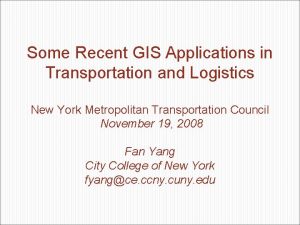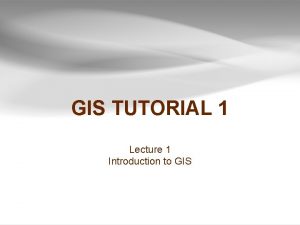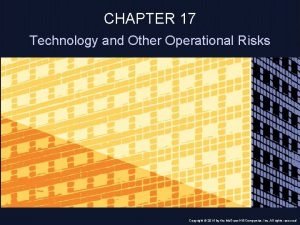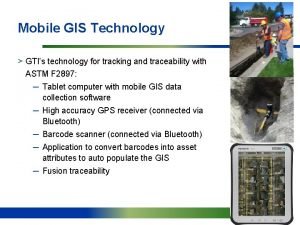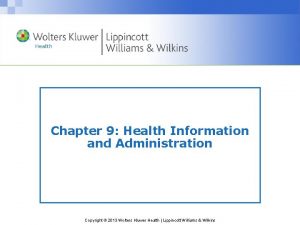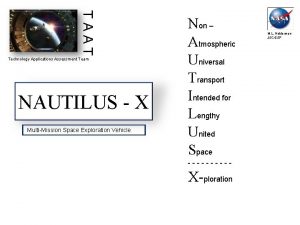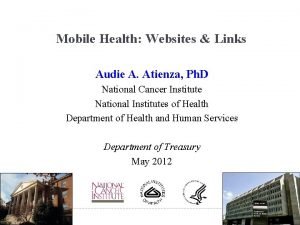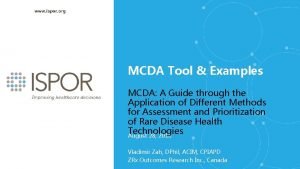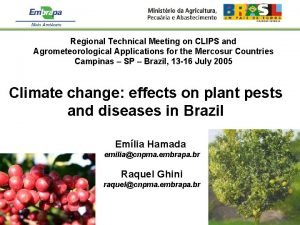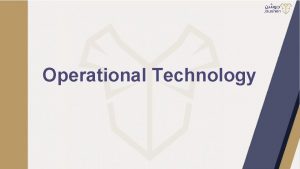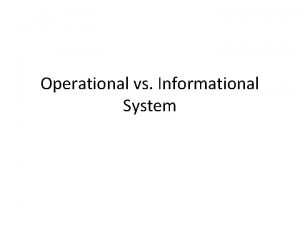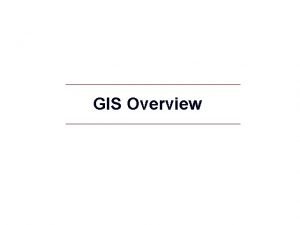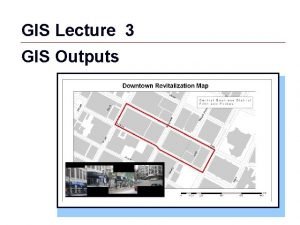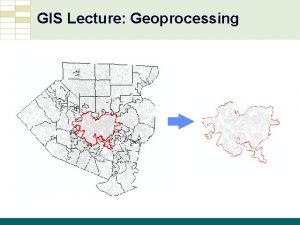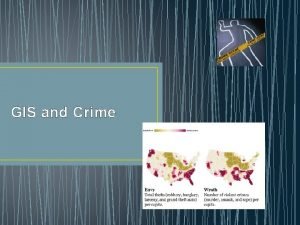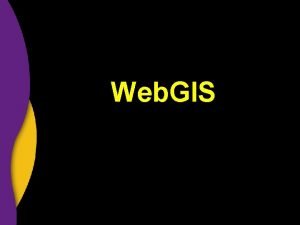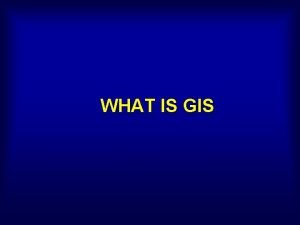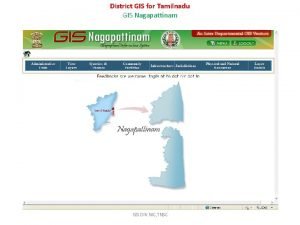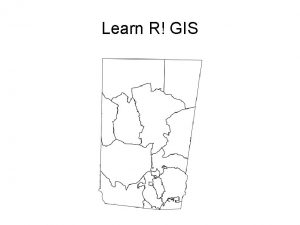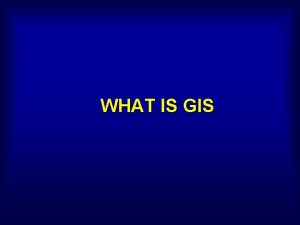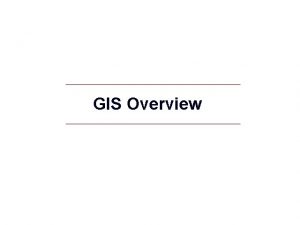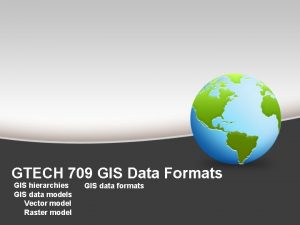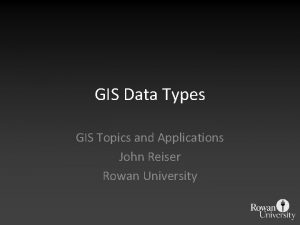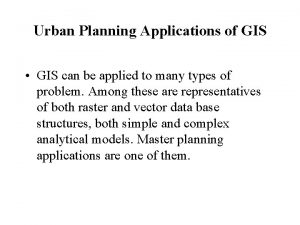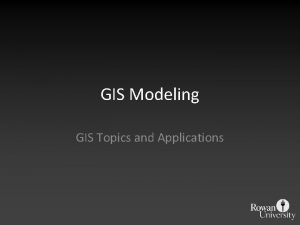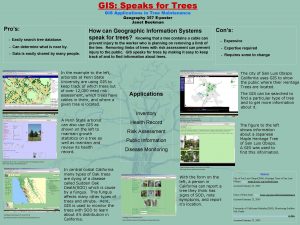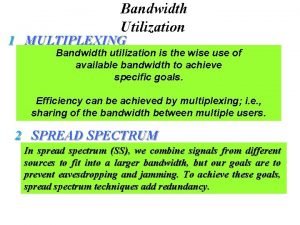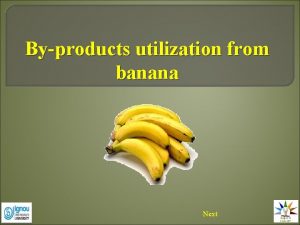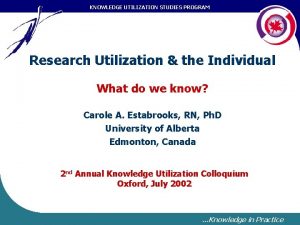Utilization of GIS Technology for Operational Agrometeorological Applications







































- Slides: 39

Utilization of GIS Technology for Operational Agrometeorological Applications Raymond P. Motha Chief Meteorologist U. S. Dept. of Agriculture Office of the Chief Economist World Agricultural Outlook Board Washington D. C. , U. S. A. World Agricultural Outlook Board

Introduction • Several analytical techniques are used to monitor crop weather worldwide – time series analyses – analog comparisons – static maps • Until recently, many maps were static and depicted just one variable, making it difficult to: – overlay data sets – visualize and evaluate relationships – easily assess crop weather conditions • Geographic Information Systems (GIS) have helped overcome these hurdles World Agricultural Outlook Board

GIS Described Simple GIS Robust GIS • GIS defined: method for organizing, displaying, and analyzing spatial data and their relationships using computers and compatible technologies • GIS incorporates quantitative data directly into the system, helping users: – overlay multiple data sets – create precise maps – perform spatial analyses • Numerous organizations use GIS to study, monitor, and model processes World Agricultural Outlook Board

GIS Users USDA Forest Service GIS used to map wildfire burn severity and to focus efforts to minimize flooding and erosion World Agricultural Outlook Board

GIS Users USDA National Agricultural Statistics Service GIS used to map crop areas annually for selected states World Agricultural Outlook Board

GIS Users USDA Farm Service Agency GIS used to delineate field boundaries, map land use, and calculate acreages World Agricultural Outlook Board

GIS Users USDA Natural Resources Conservation Service/Oregon State University GIS used to map various climatic parameters World Agricultural Outlook Board

GIS Users National Weather Service GIS used to track tropical cyclones World Agricultural Outlook Board

GIS Users Federal Emergency Management Agency GIS used to map flooding associated with a landfalling hurricane World Agricultural Outlook Board

WAOB GIS • Software – Arc. View 3. x – Arc. GIS 9. x • Hardware – 7 Pentium IV desktop computers • Processing speed 2. 4 to 2. 8 GHz • 512 MB RAM • Windows 2000/XP operating system – PCs connected via local area network – Oracle 9 i database World Agricultural Outlook Board

Data • U. S. National Weather Service – synoptic/cooperative observer data • WMO data important • NWS/WMO data archived in DBMS • Data describing extreme weather – tropical cyclone wind/coordinate data – mesonetwork temp. /precip. data • USDA National Agricultural Statistics Service (NASS) crop production, yield, and area data • NASS weekly crop progress/condition data World Agricultural Outlook Board

USDA Agrometeorological GIS Applications • WAOB GIS regularly used to create a variety of agricultural weather analyses • Products grouped into three categories: – Manual, single-parameter applications – Automated, single-parameter applications – Manual, multiple-parameter applications World Agricultural Outlook Board

Manual, Single-Parameter Applications • Refer to those WAOB products that map one agricultural or meteorological parameter and are generally laborintensive to create • Created by manually converting raw data into GIS-compatible formats and then using a GUI to import and display these data in the GIS • GUI also used to add text and legends to the crop and weather maps, and thus create the finished products World Agricultural Outlook Board

Crop Production Data – Internet U. S. Corn World Agricultural Outlook Board

Crop Production Data – Excel U. S. Corn World Agricultural Outlook Board

Crop Production Data – Arc. View U. S. Corn World Agricultural Outlook Board

Crop Maps – United States U. S. Corn World Agricultural Outlook Board

Weather Analyses – Text File Text file, comma-delimited WMO data Note latitude/longitude data in addition to weather data World Agricultural Outlook Board

Weather Analyses – GIS Table World Agricultural Outlook Board

Weather Analyses – Data Plotted World Agricultural Outlook Board

Weather Analyses – Data Contoured World Agricultural Outlook Board

Automated, Single-Parameter Applications • Similar to manual, single-parameter applications in that one agricultural or meteorological parameter is displayed analyzed on each map, however, the process for creating these products has been automated • Product creation process can be time consuming and tedious if a large number of products are desired and these products are created manually • Automation significantly reduces the time and labor required to produce these products World Agricultural Outlook Board

Avenue Scripts • Object-oriented programming language, enables users to automate various tasks associated with mapping • Examples of automation: – – – loading data spatial analysis (e. g. , contouring) defining map scale/extent annotation creating a map legend exporting/printing a map World Agricultural Outlook Board

Daily Plot Maps Green number = precipitation Red number = maximum temperature Blue number = minimum temperature Empty, partially filled, and completely filled green circles symbolize precipitation amounts World Agricultural Outlook Board

Color Contour Maps World Agricultural Outlook Board

Crop Progress & Condition Maps World Agricultural Outlook Board

Manual, Multiple-Parameter Applications • Refer to those WAOB products that map two or more agrometeorological parameters and are generally laborintensive to create • Demonstrate the significant overlay capabilities of GIS, specifically the ability to visualize – and quantify – the percent of agriculture affected by various types of weather • Often typify the special crop weather assessments prepared by WAOB meteorologists in response to extreme or severe weather World Agricultural Outlook Board

Crop Weather Analyses – Hurricane Frances World Agricultural Outlook Board

Crop Weather Analyses – Hurricane Ivan World Agricultural Outlook Board

Crop Weather Analyses – Freeze Product World Agricultural Outlook Board

Crop Weather Analyses – Drought Forecast Product World Agricultural Outlook Board

U. S. Drought Monitor – Background • In 1999, government and university scientists began working together to produce the U. S. Drought Monitor (USDM), a weekly product designed to provide a single snapshot of the spatial extent and intensity of drought in U. S. • Drought experts from four agencies are responsible for coordinating USDM production each week • On a rotating basis, an individual from one of these agencies serves as product author for the week, and typically authors the product for 2 weeks. World Agricultural Outlook Board

U. S. Drought Monitor - Methodology • Each Monday, author consults data from numerous sources 1 st draft 2 nd draft 3 rd draft FINAL – – quantitative observational networks model output satellite and radar imagery subjective reports • Author uses these data to prepare a first draft of the USDM for that week • Draft distributed via email list-server to approximately 150 people, including fellow authors and climate and water experts from around the country. World Agricultural Outlook Board

U. S. Drought Monitor - Methodology • Members of drought list provide author feedback, used to refine USDM • Through iterative process, author prepares and distributes 2 -3 drafts of the USDM during Monday, Tuesday, and Wednesday of each week to obtain the best product possible. • Final product and an accompanying text summary posted every Thursday at 0830 LT on the USDM web site: (http: //www. drought. unl. edu/dm/monitor. html) World Agricultural Outlook Board

U. S. Drought Monitor - Software • Originally prepared using Corel. Draw – unable to overlay indices – quantitative analysis not possible • USDM authors switched to Arc. GIS • Authors obtained professional training – draw drought areas – annotate map – print/export product • Initial difficulties using GIS blamed on – author inexperience – deadlines limiting troubleshooting time World Agricultural Outlook Board

U. S. Drought Monitor - Applications World Agricultural Outlook Board

North American Drought Monitor • USDM authors began collaborating with drought experts from Canada and Mexico to create NADM • Produced monthly • More frequent updates desirable, but differences in drought monitoring programs and policies prevent this • Input integrated from 3 countries – U. S. – from U. S. Drought Monitor – Mexico – drawn by USDM after consultation with Mexican experts – Canada – drawn by Canadian experts • Products remains experimental World Agricultural Outlook Board

Conclusion • Numerous organizations have recognized the benefits of using GIS to display, manage, and statistically evaluate spatial data and the relationships among multiple data sets • GIS nice because not discipline specific • Can use GIS to map and analyze any data set that has a spatial component – – – economic landmark population transportation agrometeorological data! World Agricultural Outlook Board

Thank You ! World Agricultural Outlook Board
 Gis applications in transportation
Gis applications in transportation Gis applications in civil engineering
Gis applications in civil engineering Technology and operational risk
Technology and operational risk Mobile gis technology
Mobile gis technology Human being skin as touch screen
Human being skin as touch screen Pharmaceutical biotechnology notes
Pharmaceutical biotechnology notes Recombinant dna technology applications
Recombinant dna technology applications Rdna technology applications
Rdna technology applications Recombinant dna technology applications
Recombinant dna technology applications Jazz multisensor blue eyes technology
Jazz multisensor blue eyes technology Technology applications
Technology applications Applications of blue eyes technology
Applications of blue eyes technology Recombinant dna technology applications
Recombinant dna technology applications Technology applications teks
Technology applications teks Technology applications ec-12
Technology applications ec-12 Technology applications
Technology applications Technology applications middle school
Technology applications middle school Dot product
Dot product Technology applications middle school lessons
Technology applications middle school lessons Information technology group
Information technology group Information technology applications
Information technology applications Technology applications middle school
Technology applications middle school Technology applications
Technology applications Technology applications examples
Technology applications examples Information technology applications
Information technology applications Technology applications teks
Technology applications teks Flywheelml
Flywheelml Technology applications program office
Technology applications program office Technology applications
Technology applications Rfid technology applications
Rfid technology applications Proper keyboarding technique
Proper keyboarding technique Technology applications in education
Technology applications in education Technology applications examples
Technology applications examples Technology applications
Technology applications Technology applications
Technology applications Purely native apps are binary executable image
Purely native apps are binary executable image Technology applications examples
Technology applications examples Technology applications examples
Technology applications examples Technology applications
Technology applications 6 inverse trig functions
6 inverse trig functions
